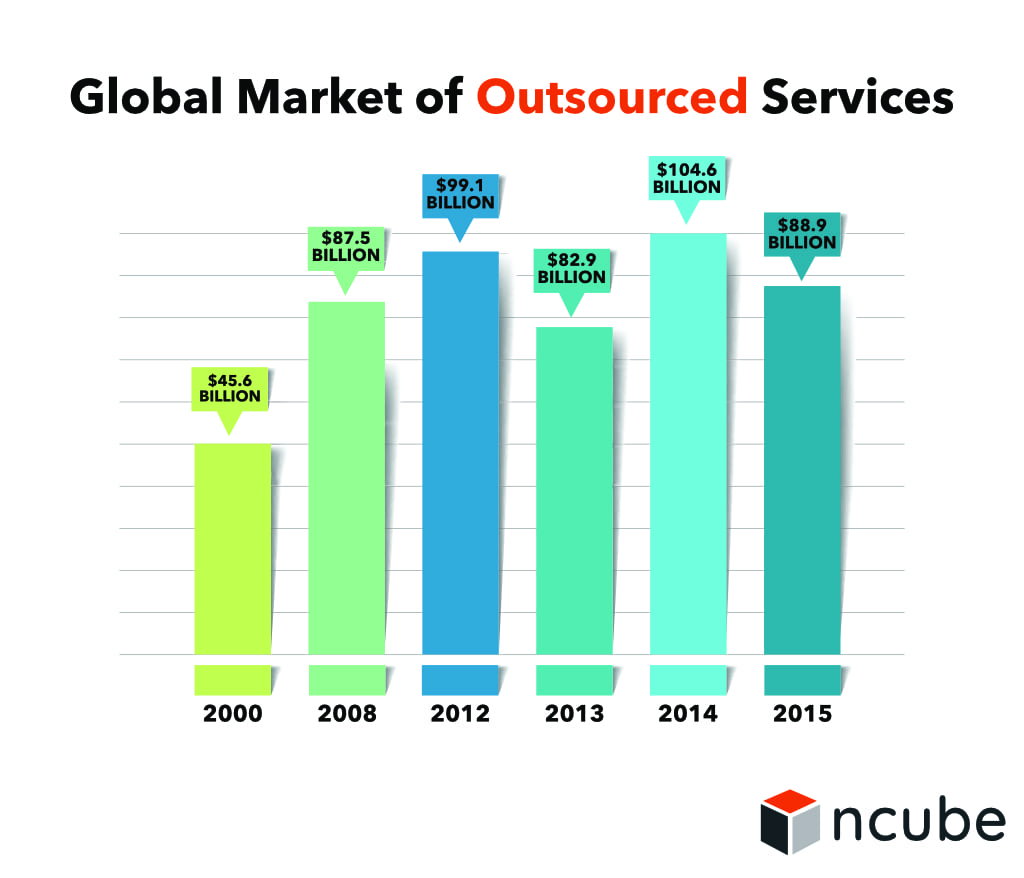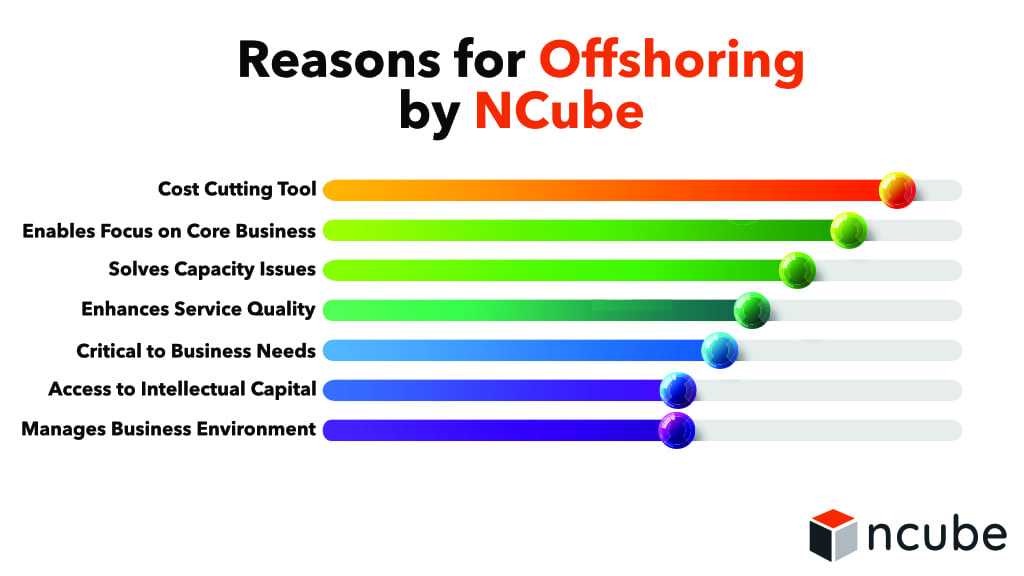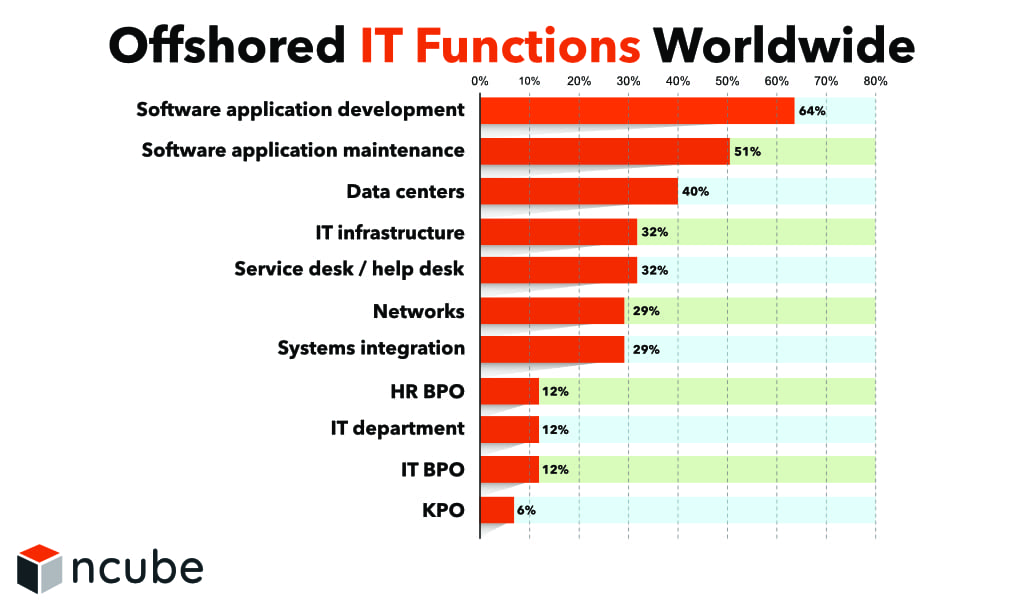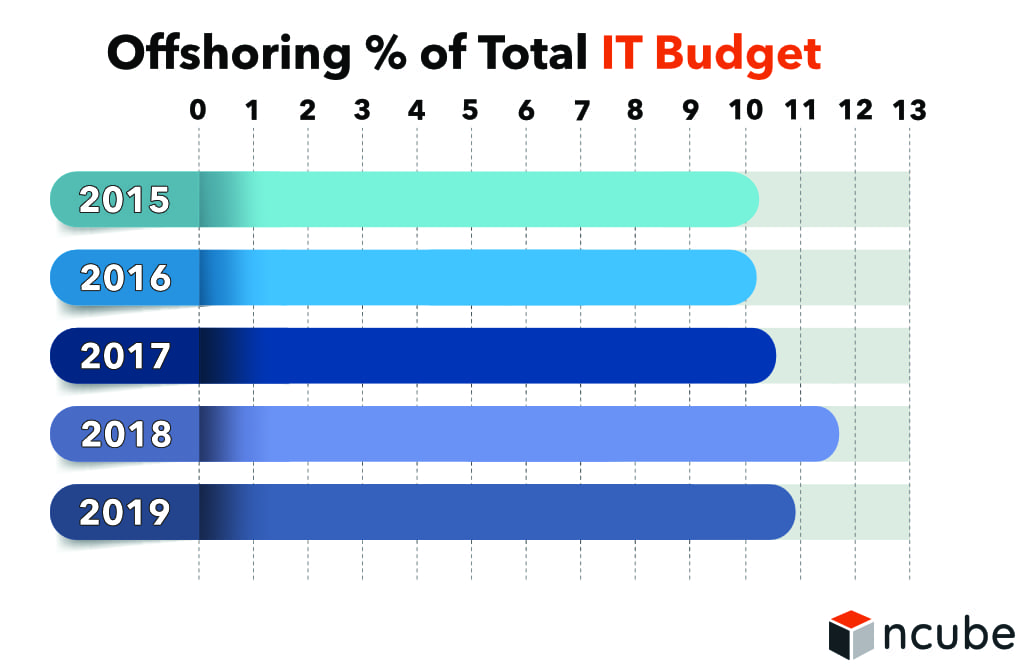
The Current State of IT Offshoring: Review by nCube

Changes in global markets and advances in technology have changed how offshore information technology companies work. While the geographic location is an essential consideration in other industries, organizations in the IT industry are much more open to a multi-location structure and hiring offshore developers. That means IT companies can capitalize on the strengths of each of their sites.
During its early years, companies considered IT offshoring to take advantage of lower overhead and potential growth. However, as technology took over the world, more and more organizations began to increase their investments in IT. Eventually, hiring offshore developers became a viable option.
The last decade brought significant changes to how businesses used and consumed IT products and resources. The advent of cloud technology improved global communication, and even the increased interconnection of global cultures have significantly changed IT offshoring work.
In this article, we will take a look at our findings on the current state of IT offshoring and outsourcing, including recent trends, driving forces, and what changed in the past years
Outsourcing vs. offshore developers
You may be asking companies to use offshoring to do what? Well, back in the early years of offshoring and outsourcing, the two business processes are easily separated. However, as globalization and internationalization permeated practically every industry, various concepts have begun to float around, blurring the line between the two.
Traditionally, offshoring refers to the organization’s movement of its activities abroad. On the other hand, outsourcing means moving activities to an offshore developers provider, regardless of its location.
However, recent decades have changed these definitions drastically. Companies that use offshore developers have combined all or parts of business offshoring and outsourcing processes to become interchangeable. That gave way to concepts such as multi-sourcing, offshore outsourcing, nearshoring, offshore IT companies, offshore software development, selective sourcing, and more.
To simplify, we define offshoring and outsourcing as providing administrative services in locations abroad, whether through an in-house department or a third-party service provider. Companies often have teams worldwide, usually combining internal teams working remotely and offshore developers hired through outsourcing entities. Hence, we will use offshoring to refer to all the concepts described above from this point on.
The current state of offshore information technology and related industries
Offshoring is not a modern phenomenon. Each generation has different motives attributed to market demands, technological advancements, and cultural intermingling.
In the past, offshoring was centered around goods. Organizations take advantage of affordable production costs and efficient distribution networks. For example, Sweden has long been known to be a popular offshoring destination for organizations in the shipbuilding, textile, and manufacturing industries in Europe.
However, modern-day offshoring efforts are driven by offshore information technology rather than goods. Thus, there was a noticeable shift in the driving forces between the late ’80s and early ’90s, which continues to this day.
First, and obviously, such low costs drive companies to consider offshore software development to maximize their profits. Second, countries outside the United States are beginning to develop their own offshore IT companies. These budding markets are perfect grounds where established companies can take new roots before prices go up. Lastly, unique factors such as excellent yet affordable infrastructure, advanced technologies, similar culture, language, and other special competencies drive companies to relate some parts of their organization, specifically the offshore information technology units.
The global state of offshore IT companies

Closely related to IT services are business processes that are commonly outsourced to BPO’s abroad. So much so that entire BPO industries have developed in India, the Philippines, and most Eastern Europe. As such, global offshore software development expenses have steadily increased throughout the years.
Since 2000, the influx of organizations entering new locations has pushed offshore information technology to new heights.

However, 2016 recorded the worst market report with only $76.9 billion, the lowest in a decade. The primary motivation of the decreasing market was the effort to cut costs and focus on core business processes. This means more organizations are spending more on new solutions through IT services than on offshore developers.

The trends in offshore IT companies had exciting effects on the IT industry. In 2018, business process outsourcing had a much smaller market share than information technology offshoring. The BPO industry only contributed $23.6 billion compared to the offshore information technology’s $62 billion offshoring revenue.
The 2017 report of the most outsourced and offshored services of IT leaders worldwide reflects this trend as well. Software application development took the top spot at 64 percent. Similarly, IT functions dominate the top offshored services in the last few years.

Interestingly, there is a rising trend in the IT offshoring business in recent years. Between 2017 and 2018, there is a slight drop in allotted budgets for offshore software development. Even with large companies increasing their total expenditures, medium and small companies are turning to cloud technology, which is much more affordable.

Again, this recent trend seems to reflect the prediction during 2016 when cloud technology is taking off rapidly and set to disrupt the global market.
Offshore developers: training and opportunities
With the move from exclusively outsourcing from the labor force to offshoring IT services, offshore developers have become the top export of most outsourcing countries. In the above graph, access to intellectual capital is one of the driving forces of offshore IT companies.
The skill level and prices are top priorities in hiring offshore teams. Eastern Europe and the surrounding regions are known to be excellent sources of top offshore developers in the West. Russia, Ukraine, and Poland are leading the pack with exceptional offshore developers who possess business knowledge and communication.
Additionally, Latin America is a favorable region for companies that do not want to deal with severe time differences. Brazil is becoming a leading country for offshore developers specialized in Ruby, which is always in demand.
Hire software
Finally, Asia has always been a hotbed of offshore software development with BPO’s and offshore IT organizations targeting countries like India and China even during the early years of outsourcing. Even with significant language barriers, more and more businesses are considering relocation in this region due to affordable business operation costs. Also, more and more countries are emerging in the IT sector and offshoring markets such as Pakistan, the Philippines, Thailand, and more.
Offshore developers: opportunities

As with recent innovations in communication, cloud technology, and infrastructure, we do not see IT offshoring slowing down any time soon. As more areas become viable offshore developers’ pools of IT skills, companies are beginning to look at countries beyond offshore software development.
Organizations are beginning to realize the advantages of hiring offshore developers. Even small and medium-sized companies are looking at IT solutions developed by offshore developers and IT professionals outside their location.
Just like the difference between offshoring and outsourcing, geographical limitations are blurred, allowing organizations to set up offshore software development units across the world. Let’s take a look at one of the rising IT talent sources in Europe: Ukraine.
Offshoring spotlight: Ukrainian offshore developers
In recent years, Ukraine has been one of the top countries as the primary destinations of IT offshoring companies. As a result, the country is poised to compete with India and China in offshore developers’ availability and training in information technology.
Our observation in the last five years showed an increase of about 20 percent in human capital in the Ukrainian offshore IT companies. Since 2011, the IT sector has doubled with more fresh talents coming in every year.
Nowadays, more and more companies have offshore developers across Europe, just like nCube. With offices in both London and Kyiv, the company is able to take advantage of top-quality talent and high-profile clients across the region. The organization comprises senior offshore developers and Master’s degree holders, with 70% certified senior offshore developers. That reflects the country’s top-notch training in IT and related professional consultants.
nCube’s remote teams are experts in Java, Go, Javascript, Python, and .NET, which are the most in-demand programming languages right now. Organizations inside and outside Europe can build a remote team of offshore developers to create custom software for their specific needs.
Along with expertise in offshore software development, the company is also delving into emerging industries like blockchain and Internet-of-Things. As exemplified by nCube, Ukrainian offshore developers are becoming leaders in bleeding-edge technology.
Offshore IT companies: Final Thoughts
IT offshoring will continue to shift as new technologies emerge. Regardless of the current trends, we see an ever-expanding industry ripe with many opportunities for both businesses and the workforce. Organizations are no longer limited by their locations. In the future, we expect to see a further redefinition of offshore IT companies and outsourcing processes as the industry continues to snowball.
Recommended articles



